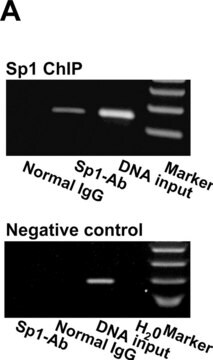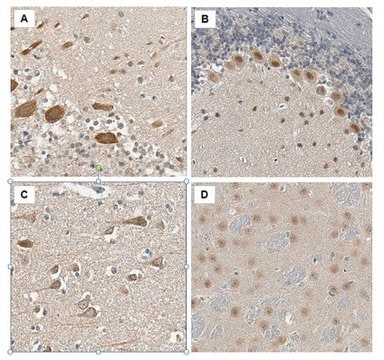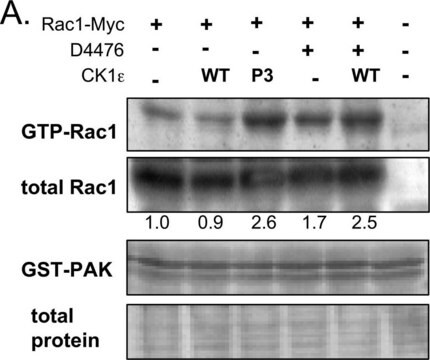推薦產品
一般說明
Sp1 was one of the first transcription factors to be characterized in mammalian cells. The Sp1 protein plays a role in the regulation of gene expression. This protein has three Cys2His2 zinc-finger motifs that have been shown to bind to the consensus sequence 5′-(G/T)GGGCGG(G/A)(G/A)(C/T)-3′ also known as a GC box. Sp1 is a ubiquitous transcription factor required for the expression of a variety of genes, such as those involved in the cell cycle and development. Interaction of the Sp1 protein with the GC box activates transcription of specific mRNAs from genes that contain functional recognition sites.
特異性
Homology to chimpanzee, canine, and rhesus monkey is 99%.
This antibody recognizes Sp1.
免疫原
GST-tagged recombinant protein corresponding to full-length human Sp1.
應用
Anti-Sp1 Antibody is a Rabbit Polyclonal Antibody for detection of Sp1 also known as Sp1 transcription factor, specificity protein 1 & has been validated in WB, IP, ICC.
Immunocytochemistry Analysis: 1:500 dilution from a representative lot detected Sp1 in HeLa and A431 cells.
Immunoprecipitation Analysis: 10 µg from a representative lot immunoprecipitated Sp1 from 500 µg of HeLa nuclear extract.
Immunoprecipitation Analysis: 10 µg from a representative lot immunoprecipitated Sp1 from 500 µg of HeLa nuclear extract.
Research Category
Epigenetics & Nuclear Function
Epigenetics & Nuclear Function
Research Sub Category
Transcription Factors
Transcription Factors
品質
Evaluated by Western Blot in HeLa nuclear extract.
Western Blot Analysis: 0.1 µg/mL of this antibody detected Sp1 on 10 µg of HeLa nuclear extract.
Western Blot Analysis: 0.1 µg/mL of this antibody detected Sp1 on 10 µg of HeLa nuclear extract.
標靶描述
95 kDa and 105 kDa
聯結
Replaces: MABE550
外觀
Protein A purified
Format: Purified
Purified rabbit polyclonal in buffer containing 0.1 M Tris-Glycine (pH 7.4, 150 mM NaCl) with 0.05% sodium azide.
儲存和穩定性
Stable for 1 year at 2-8°C from date of receipt.
分析報告
Control
HeLa nuclear extract
HeLa nuclear extract
其他說明
Concentration: Please refer to the Certificate of Analysis for the lot-specific concentration.
免責聲明
Unless otherwise stated in our catalog or other company documentation accompanying the product(s), our products are intended for research use only and are not to be used for any other purpose, which includes but is not limited to, unauthorized commercial uses, in vitro diagnostic uses, ex vivo or in vivo therapeutic uses or any type of consumption or application to humans or animals.
Not finding the right product?
Try our 產品選擇工具.
儲存類別代碼
12 - Non Combustible Liquids
水污染物質分類(WGK)
WGK 1
閃點(°F)
Not applicable
閃點(°C)
Not applicable
分析證明 (COA)
輸入產品批次/批號來搜索 分析證明 (COA)。在產品’s標籤上找到批次和批號,寫有 ‘Lot’或‘Batch’.。
Adrien Morel et al.
Oncotarget, 8(28), 46163-46176 (2017-05-19)
High-risk human papillomaviruses are the etiological agents of cervical cancer and HPV16 is the most oncogenic genotype. Immortalization and transformation of infected cells requires the overexpression of the two viral oncoproteins E6 and E7 following HPV DNA integration into the
Christoph Hoffmann et al.
PloS one, 8(12), e83426-e83426 (2014-01-07)
Uncoupling protein (UCP) 3 is a mitochondrial inner membrane protein implicated in lipid handling and metabolism of reactive oxygen species. Its transcription is mainly regulated by peroxisome proliferator-activated receptors (PPAR), a family of nuclear hormone receptors. Employing bandshift assays, RNA
Lina Adwan et al.
Neuropharmacology, 79, 596-602 (2014-01-28)
Environmental exposure to lead (Pb) early in life results in a latent upregulation of genes and products associated with Alzheimer's disease (AD), particularly the plaque forming protein amyloid beta (Aβ). Furthermore, animals exposed to Pb as infants develop cognitive decline
K A Gajewska et al.
Nature communications, 12(1), 5904-5904 (2021-10-10)
The importin superfamily member Importin-13 is a bidirectional nuclear transporter. To delineate its functional roles, we performed transcriptomic analysis on wild-type and Importin-13-knockout mouse embryonic stem cells, revealing enrichment of differentially expressed genes involved in stress responses and apoptosis regulation.
Sandra Kissing et al.
Autophagy, 13(4), 670-685 (2017-01-28)
The vacuolar-type H+-translocating ATPase (v-H+-ATPase) has been implicated in the amino acid-dependent activation of the mechanistic target of rapamycin complex 1 (MTORC1), an important regulator of macroautophagy. To reveal the mechanistic links between the v-H+-ATPase and MTORC1, we destablilized v-H+-ATPase
我們的科學家團隊在所有研究領域都有豐富的經驗,包括生命科學、材料科學、化學合成、色譜、分析等.
聯絡技術服務








